Primary Health Care: Community Nurse in Aboriginal Health Services
VerifiedAdded on 2023/06/10
|10
|2740
|51
Essay
AI Summary
This essay explores the crucial role of community nurses within Aboriginal Community Controlled Health Services (ACCHS) in Australia, addressing the health disparities between Indigenous and non-Indigenous populations. It highlights how ACCHSs provide culturally appropriate and comprehensive primary healthcare to Aboriginal and Torres Strait Islander peoples, emphasizing the importance of community involvement and culturally competent healthcare professionals. The essay discusses the holistic approach of primary healthcare in this context, encompassing physical, emotional, social, and cultural factors, and emphasizes the significance of addressing social determinants of health. It further elaborates on the responsibilities of community nurses in health promotion, disease prevention, and advocacy, stressing the need for collaboration with community leaders and other sectors to improve the overall well-being of Indigenous communities. The essay concludes that community nurses play a vital role in bridging the gap in healthcare access and outcomes for Aboriginal and Torres Strait Islander peoples by providing culturally sensitive care and addressing the underlying social factors affecting their health.
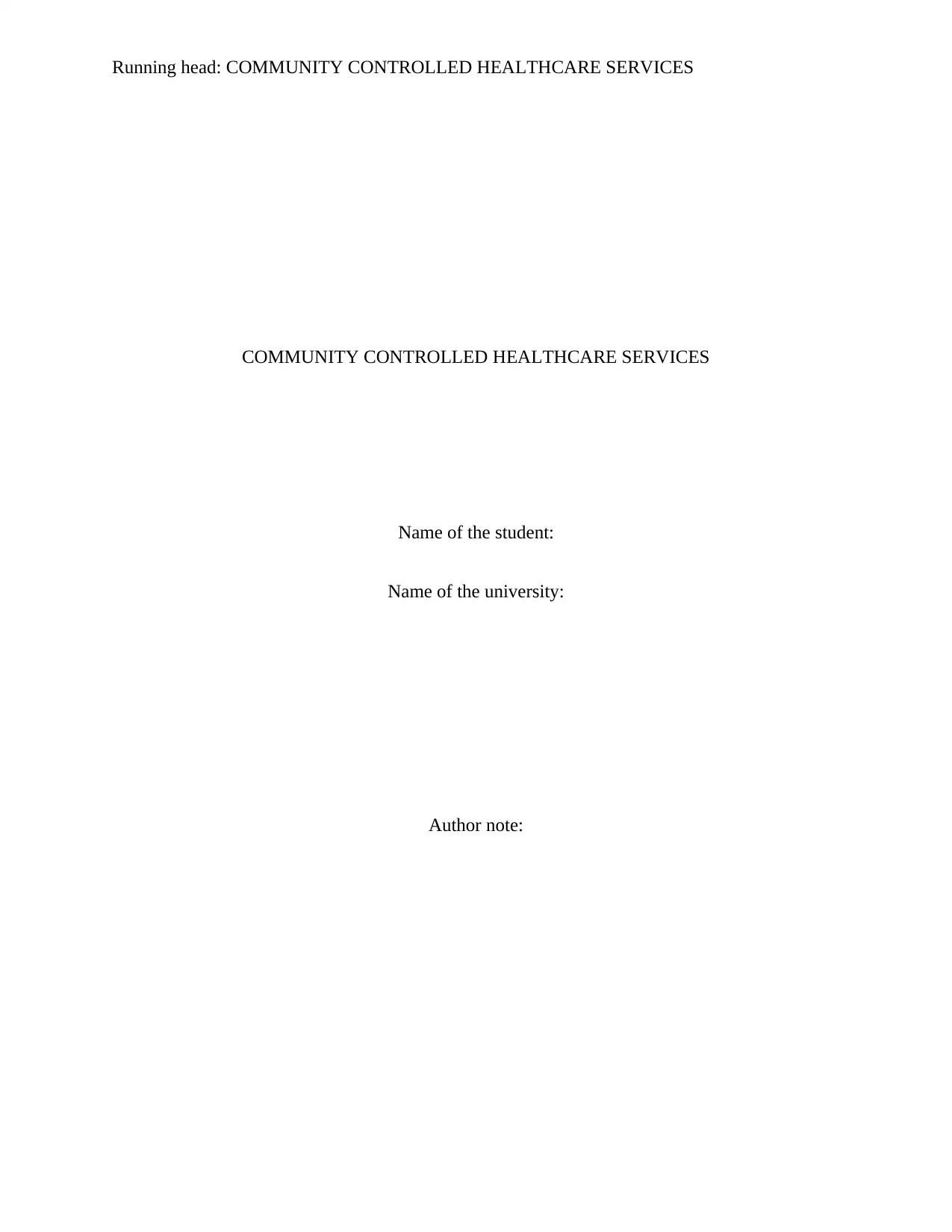
Running head: COMMUNITY CONTROLLED HEALTHCARE SERVICES
COMMUNITY CONTROLLED HEALTHCARE SERVICES
Name of the student:
Name of the university:
Author note:
COMMUNITY CONTROLLED HEALTHCARE SERVICES
Name of the student:
Name of the university:
Author note:
Paraphrase This Document
Need a fresh take? Get an instant paraphrase of this document with our AI Paraphraser
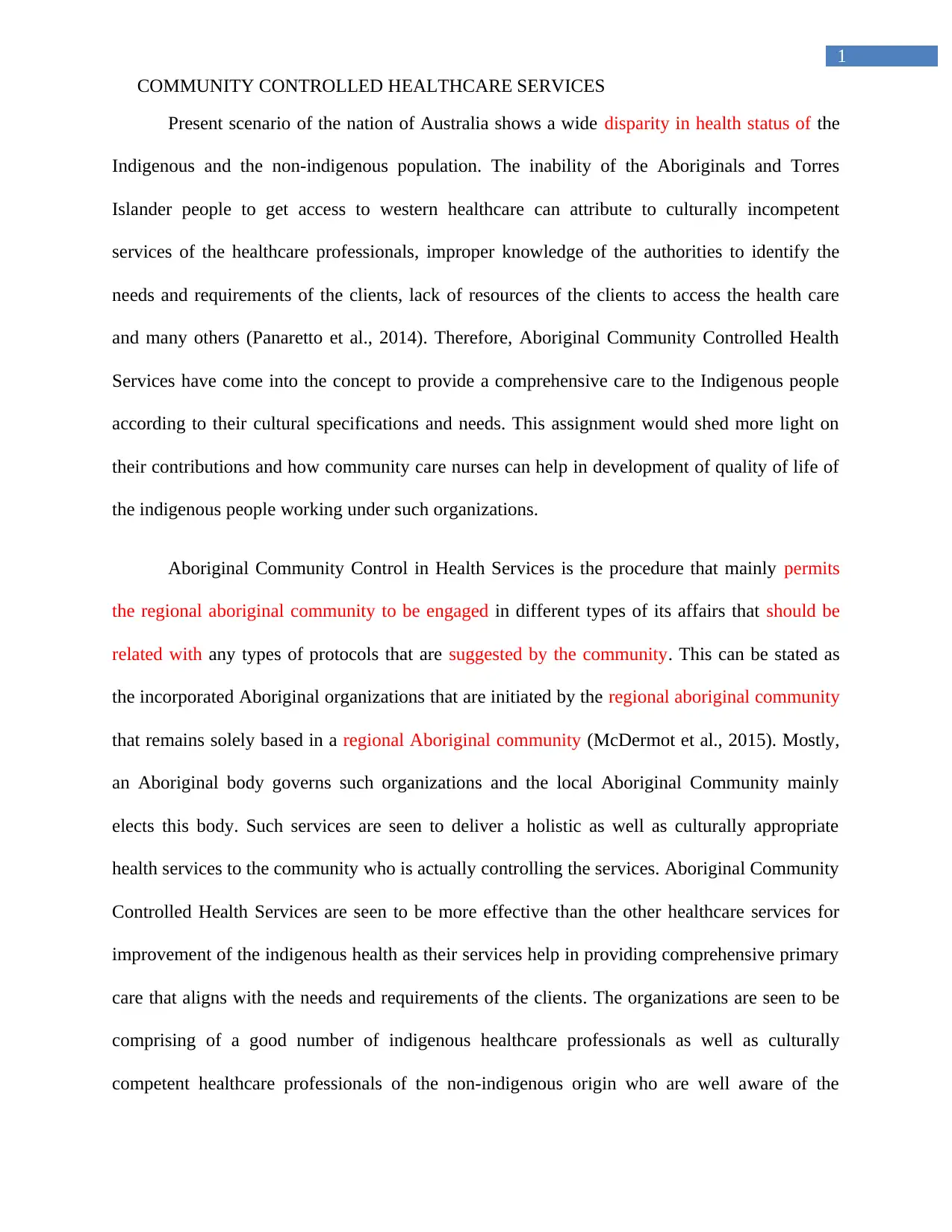
1
COMMUNITY CONTROLLED HEALTHCARE SERVICES
Present scenario of the nation of Australia shows a wide disparity in health status of the
Indigenous and the non-indigenous population. The inability of the Aboriginals and Torres
Islander people to get access to western healthcare can attribute to culturally incompetent
services of the healthcare professionals, improper knowledge of the authorities to identify the
needs and requirements of the clients, lack of resources of the clients to access the health care
and many others (Panaretto et al., 2014). Therefore, Aboriginal Community Controlled Health
Services have come into the concept to provide a comprehensive care to the Indigenous people
according to their cultural specifications and needs. This assignment would shed more light on
their contributions and how community care nurses can help in development of quality of life of
the indigenous people working under such organizations.
Aboriginal Community Control in Health Services is the procedure that mainly permits
the regional aboriginal community to be engaged in different types of its affairs that should be
related with any types of protocols that are suggested by the community. This can be stated as
the incorporated Aboriginal organizations that are initiated by the regional aboriginal community
that remains solely based in a regional Aboriginal community (McDermot et al., 2015). Mostly,
an Aboriginal body governs such organizations and the local Aboriginal Community mainly
elects this body. Such services are seen to deliver a holistic as well as culturally appropriate
health services to the community who is actually controlling the services. Aboriginal Community
Controlled Health Services are seen to be more effective than the other healthcare services for
improvement of the indigenous health as their services help in providing comprehensive primary
care that aligns with the needs and requirements of the clients. The organizations are seen to be
comprising of a good number of indigenous healthcare professionals as well as culturally
competent healthcare professionals of the non-indigenous origin who are well aware of the
COMMUNITY CONTROLLED HEALTHCARE SERVICES
Present scenario of the nation of Australia shows a wide disparity in health status of the
Indigenous and the non-indigenous population. The inability of the Aboriginals and Torres
Islander people to get access to western healthcare can attribute to culturally incompetent
services of the healthcare professionals, improper knowledge of the authorities to identify the
needs and requirements of the clients, lack of resources of the clients to access the health care
and many others (Panaretto et al., 2014). Therefore, Aboriginal Community Controlled Health
Services have come into the concept to provide a comprehensive care to the Indigenous people
according to their cultural specifications and needs. This assignment would shed more light on
their contributions and how community care nurses can help in development of quality of life of
the indigenous people working under such organizations.
Aboriginal Community Control in Health Services is the procedure that mainly permits
the regional aboriginal community to be engaged in different types of its affairs that should be
related with any types of protocols that are suggested by the community. This can be stated as
the incorporated Aboriginal organizations that are initiated by the regional aboriginal community
that remains solely based in a regional Aboriginal community (McDermot et al., 2015). Mostly,
an Aboriginal body governs such organizations and the local Aboriginal Community mainly
elects this body. Such services are seen to deliver a holistic as well as culturally appropriate
health services to the community who is actually controlling the services. Aboriginal Community
Controlled Health Services are seen to be more effective than the other healthcare services for
improvement of the indigenous health as their services help in providing comprehensive primary
care that aligns with the needs and requirements of the clients. The organizations are seen to be
comprising of a good number of indigenous healthcare professionals as well as culturally
competent healthcare professionals of the non-indigenous origin who are well aware of the
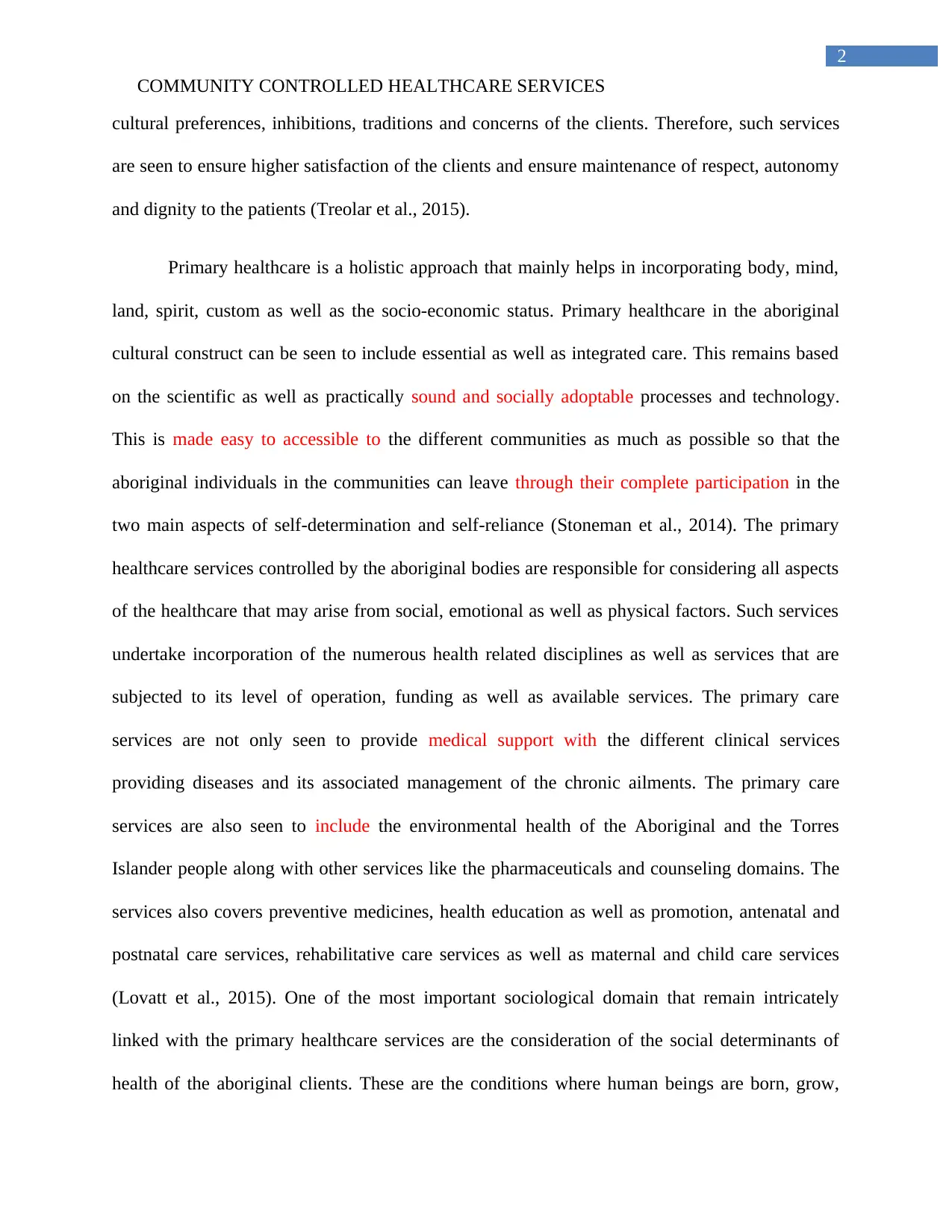
2
COMMUNITY CONTROLLED HEALTHCARE SERVICES
cultural preferences, inhibitions, traditions and concerns of the clients. Therefore, such services
are seen to ensure higher satisfaction of the clients and ensure maintenance of respect, autonomy
and dignity to the patients (Treolar et al., 2015).
Primary healthcare is a holistic approach that mainly helps in incorporating body, mind,
land, spirit, custom as well as the socio-economic status. Primary healthcare in the aboriginal
cultural construct can be seen to include essential as well as integrated care. This remains based
on the scientific as well as practically sound and socially adoptable processes and technology.
This is made easy to accessible to the different communities as much as possible so that the
aboriginal individuals in the communities can leave through their complete participation in the
two main aspects of self-determination and self-reliance (Stoneman et al., 2014). The primary
healthcare services controlled by the aboriginal bodies are responsible for considering all aspects
of the healthcare that may arise from social, emotional as well as physical factors. Such services
undertake incorporation of the numerous health related disciplines as well as services that are
subjected to its level of operation, funding as well as available services. The primary care
services are not only seen to provide medical support with the different clinical services
providing diseases and its associated management of the chronic ailments. The primary care
services are also seen to include the environmental health of the Aboriginal and the Torres
Islander people along with other services like the pharmaceuticals and counseling domains. The
services also covers preventive medicines, health education as well as promotion, antenatal and
postnatal care services, rehabilitative care services as well as maternal and child care services
(Lovatt et al., 2015). One of the most important sociological domain that remain intricately
linked with the primary healthcare services are the consideration of the social determinants of
health of the aboriginal clients. These are the conditions where human beings are born, grow,
COMMUNITY CONTROLLED HEALTHCARE SERVICES
cultural preferences, inhibitions, traditions and concerns of the clients. Therefore, such services
are seen to ensure higher satisfaction of the clients and ensure maintenance of respect, autonomy
and dignity to the patients (Treolar et al., 2015).
Primary healthcare is a holistic approach that mainly helps in incorporating body, mind,
land, spirit, custom as well as the socio-economic status. Primary healthcare in the aboriginal
cultural construct can be seen to include essential as well as integrated care. This remains based
on the scientific as well as practically sound and socially adoptable processes and technology.
This is made easy to accessible to the different communities as much as possible so that the
aboriginal individuals in the communities can leave through their complete participation in the
two main aspects of self-determination and self-reliance (Stoneman et al., 2014). The primary
healthcare services controlled by the aboriginal bodies are responsible for considering all aspects
of the healthcare that may arise from social, emotional as well as physical factors. Such services
undertake incorporation of the numerous health related disciplines as well as services that are
subjected to its level of operation, funding as well as available services. The primary care
services are not only seen to provide medical support with the different clinical services
providing diseases and its associated management of the chronic ailments. The primary care
services are also seen to include the environmental health of the Aboriginal and the Torres
Islander people along with other services like the pharmaceuticals and counseling domains. The
services also covers preventive medicines, health education as well as promotion, antenatal and
postnatal care services, rehabilitative care services as well as maternal and child care services
(Lovatt et al., 2015). One of the most important sociological domain that remain intricately
linked with the primary healthcare services are the consideration of the social determinants of
health of the aboriginal clients. These are the conditions where human beings are born, grow,
⊘ This is a preview!⊘
Do you want full access?
Subscribe today to unlock all pages.

Trusted by 1+ million students worldwide
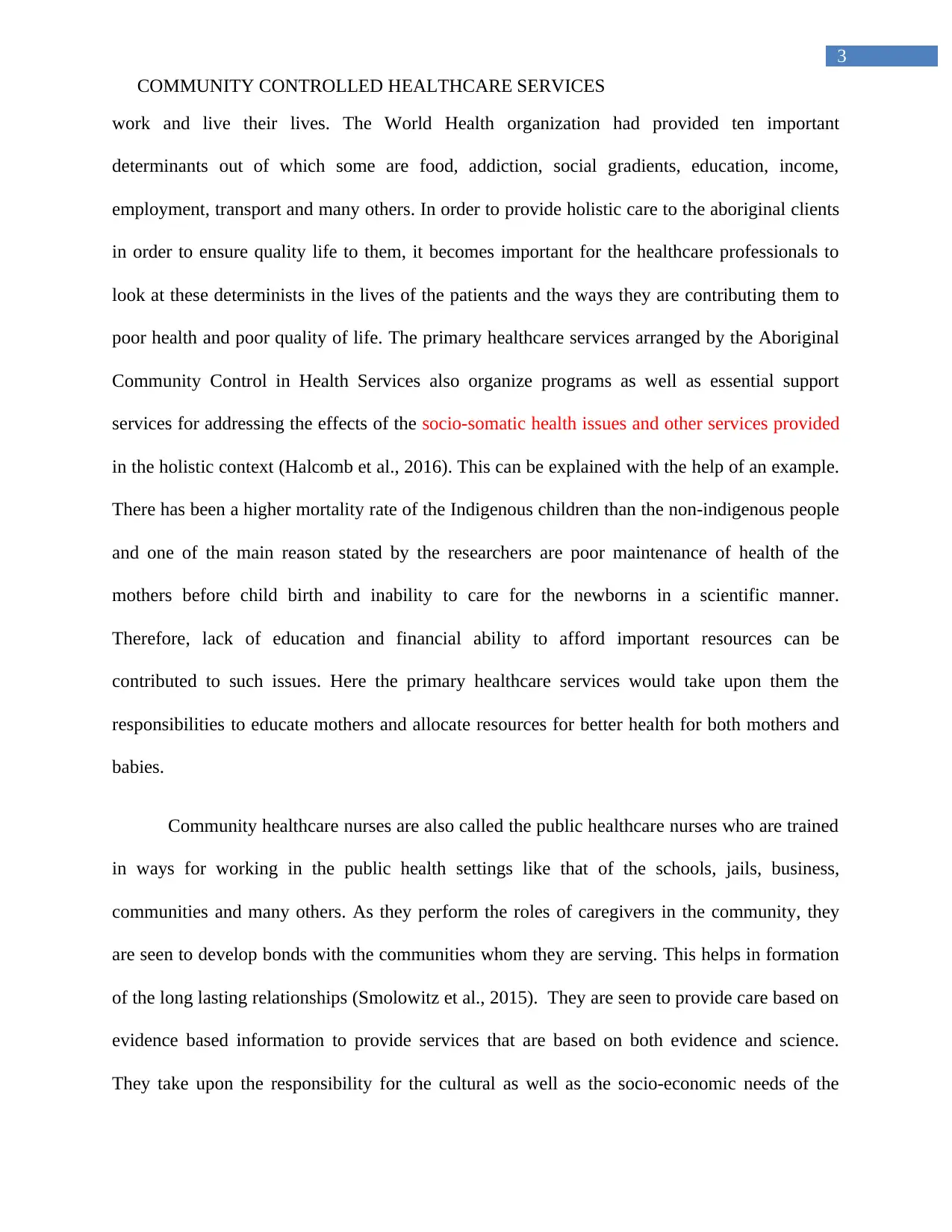
3
COMMUNITY CONTROLLED HEALTHCARE SERVICES
work and live their lives. The World Health organization had provided ten important
determinants out of which some are food, addiction, social gradients, education, income,
employment, transport and many others. In order to provide holistic care to the aboriginal clients
in order to ensure quality life to them, it becomes important for the healthcare professionals to
look at these determinists in the lives of the patients and the ways they are contributing them to
poor health and poor quality of life. The primary healthcare services arranged by the Aboriginal
Community Control in Health Services also organize programs as well as essential support
services for addressing the effects of the socio-somatic health issues and other services provided
in the holistic context (Halcomb et al., 2016). This can be explained with the help of an example.
There has been a higher mortality rate of the Indigenous children than the non-indigenous people
and one of the main reason stated by the researchers are poor maintenance of health of the
mothers before child birth and inability to care for the newborns in a scientific manner.
Therefore, lack of education and financial ability to afford important resources can be
contributed to such issues. Here the primary healthcare services would take upon them the
responsibilities to educate mothers and allocate resources for better health for both mothers and
babies.
Community healthcare nurses are also called the public healthcare nurses who are trained
in ways for working in the public health settings like that of the schools, jails, business,
communities and many others. As they perform the roles of caregivers in the community, they
are seen to develop bonds with the communities whom they are serving. This helps in formation
of the long lasting relationships (Smolowitz et al., 2015). They are seen to provide care based on
evidence based information to provide services that are based on both evidence and science.
They take upon the responsibility for the cultural as well as the socio-economic needs of the
COMMUNITY CONTROLLED HEALTHCARE SERVICES
work and live their lives. The World Health organization had provided ten important
determinants out of which some are food, addiction, social gradients, education, income,
employment, transport and many others. In order to provide holistic care to the aboriginal clients
in order to ensure quality life to them, it becomes important for the healthcare professionals to
look at these determinists in the lives of the patients and the ways they are contributing them to
poor health and poor quality of life. The primary healthcare services arranged by the Aboriginal
Community Control in Health Services also organize programs as well as essential support
services for addressing the effects of the socio-somatic health issues and other services provided
in the holistic context (Halcomb et al., 2016). This can be explained with the help of an example.
There has been a higher mortality rate of the Indigenous children than the non-indigenous people
and one of the main reason stated by the researchers are poor maintenance of health of the
mothers before child birth and inability to care for the newborns in a scientific manner.
Therefore, lack of education and financial ability to afford important resources can be
contributed to such issues. Here the primary healthcare services would take upon them the
responsibilities to educate mothers and allocate resources for better health for both mothers and
babies.
Community healthcare nurses are also called the public healthcare nurses who are trained
in ways for working in the public health settings like that of the schools, jails, business,
communities and many others. As they perform the roles of caregivers in the community, they
are seen to develop bonds with the communities whom they are serving. This helps in formation
of the long lasting relationships (Smolowitz et al., 2015). They are seen to provide care based on
evidence based information to provide services that are based on both evidence and science.
They take upon the responsibility for the cultural as well as the socio-economic needs of the
Paraphrase This Document
Need a fresh take? Get an instant paraphrase of this document with our AI Paraphraser
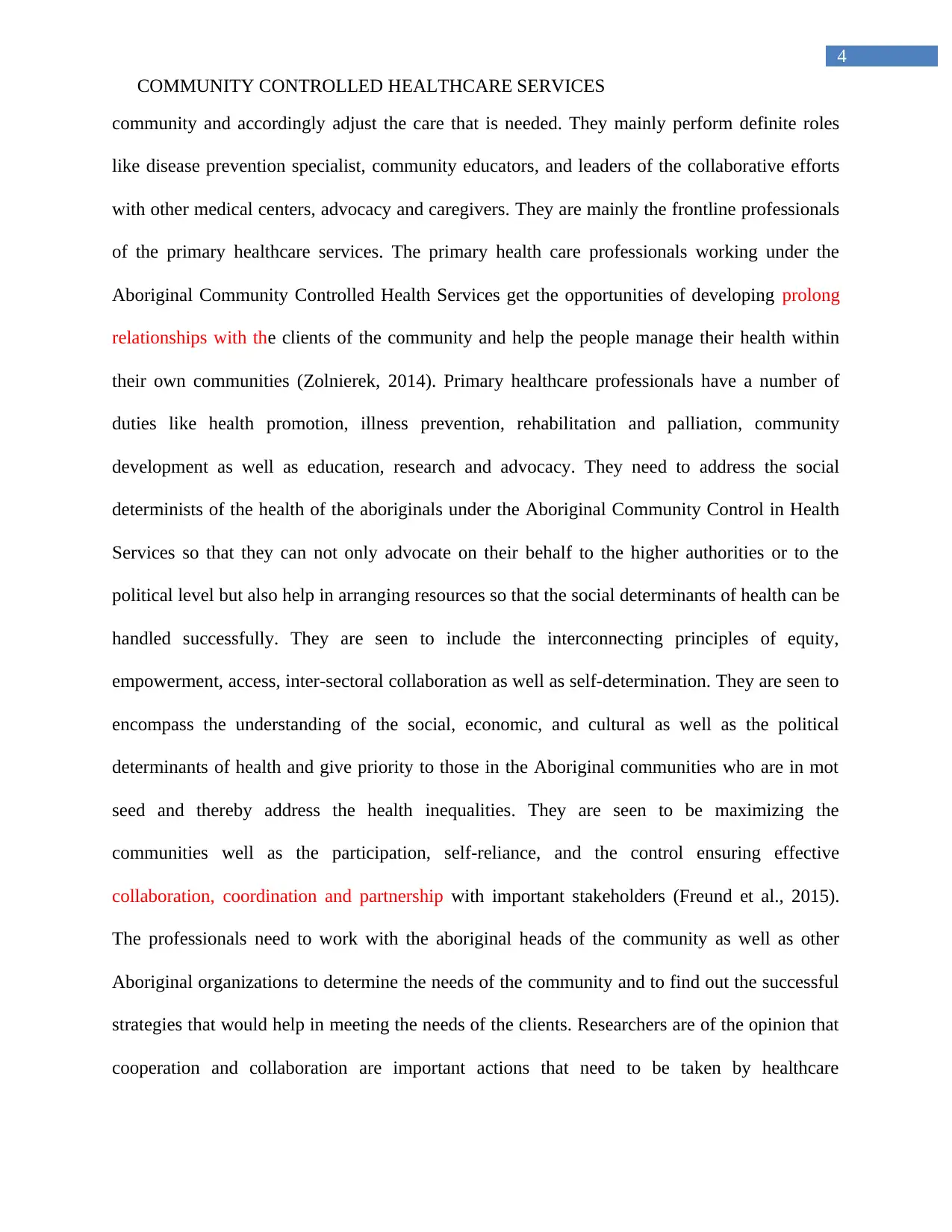
4
COMMUNITY CONTROLLED HEALTHCARE SERVICES
community and accordingly adjust the care that is needed. They mainly perform definite roles
like disease prevention specialist, community educators, and leaders of the collaborative efforts
with other medical centers, advocacy and caregivers. They are mainly the frontline professionals
of the primary healthcare services. The primary health care professionals working under the
Aboriginal Community Controlled Health Services get the opportunities of developing prolong
relationships with the clients of the community and help the people manage their health within
their own communities (Zolnierek, 2014). Primary healthcare professionals have a number of
duties like health promotion, illness prevention, rehabilitation and palliation, community
development as well as education, research and advocacy. They need to address the social
determinists of the health of the aboriginals under the Aboriginal Community Control in Health
Services so that they can not only advocate on their behalf to the higher authorities or to the
political level but also help in arranging resources so that the social determinants of health can be
handled successfully. They are seen to include the interconnecting principles of equity,
empowerment, access, inter-sectoral collaboration as well as self-determination. They are seen to
encompass the understanding of the social, economic, and cultural as well as the political
determinants of health and give priority to those in the Aboriginal communities who are in mot
seed and thereby address the health inequalities. They are seen to be maximizing the
communities well as the participation, self-reliance, and the control ensuring effective
collaboration, coordination and partnership with important stakeholders (Freund et al., 2015).
The professionals need to work with the aboriginal heads of the community as well as other
Aboriginal organizations to determine the needs of the community and to find out the successful
strategies that would help in meeting the needs of the clients. Researchers are of the opinion that
cooperation and collaboration are important actions that need to be taken by healthcare
COMMUNITY CONTROLLED HEALTHCARE SERVICES
community and accordingly adjust the care that is needed. They mainly perform definite roles
like disease prevention specialist, community educators, and leaders of the collaborative efforts
with other medical centers, advocacy and caregivers. They are mainly the frontline professionals
of the primary healthcare services. The primary health care professionals working under the
Aboriginal Community Controlled Health Services get the opportunities of developing prolong
relationships with the clients of the community and help the people manage their health within
their own communities (Zolnierek, 2014). Primary healthcare professionals have a number of
duties like health promotion, illness prevention, rehabilitation and palliation, community
development as well as education, research and advocacy. They need to address the social
determinists of the health of the aboriginals under the Aboriginal Community Control in Health
Services so that they can not only advocate on their behalf to the higher authorities or to the
political level but also help in arranging resources so that the social determinants of health can be
handled successfully. They are seen to include the interconnecting principles of equity,
empowerment, access, inter-sectoral collaboration as well as self-determination. They are seen to
encompass the understanding of the social, economic, and cultural as well as the political
determinants of health and give priority to those in the Aboriginal communities who are in mot
seed and thereby address the health inequalities. They are seen to be maximizing the
communities well as the participation, self-reliance, and the control ensuring effective
collaboration, coordination and partnership with important stakeholders (Freund et al., 2015).
The professionals need to work with the aboriginal heads of the community as well as other
Aboriginal organizations to determine the needs of the community and to find out the successful
strategies that would help in meeting the needs of the clients. Researchers are of the opinion that
cooperation and collaboration are important actions that need to be taken by healthcare
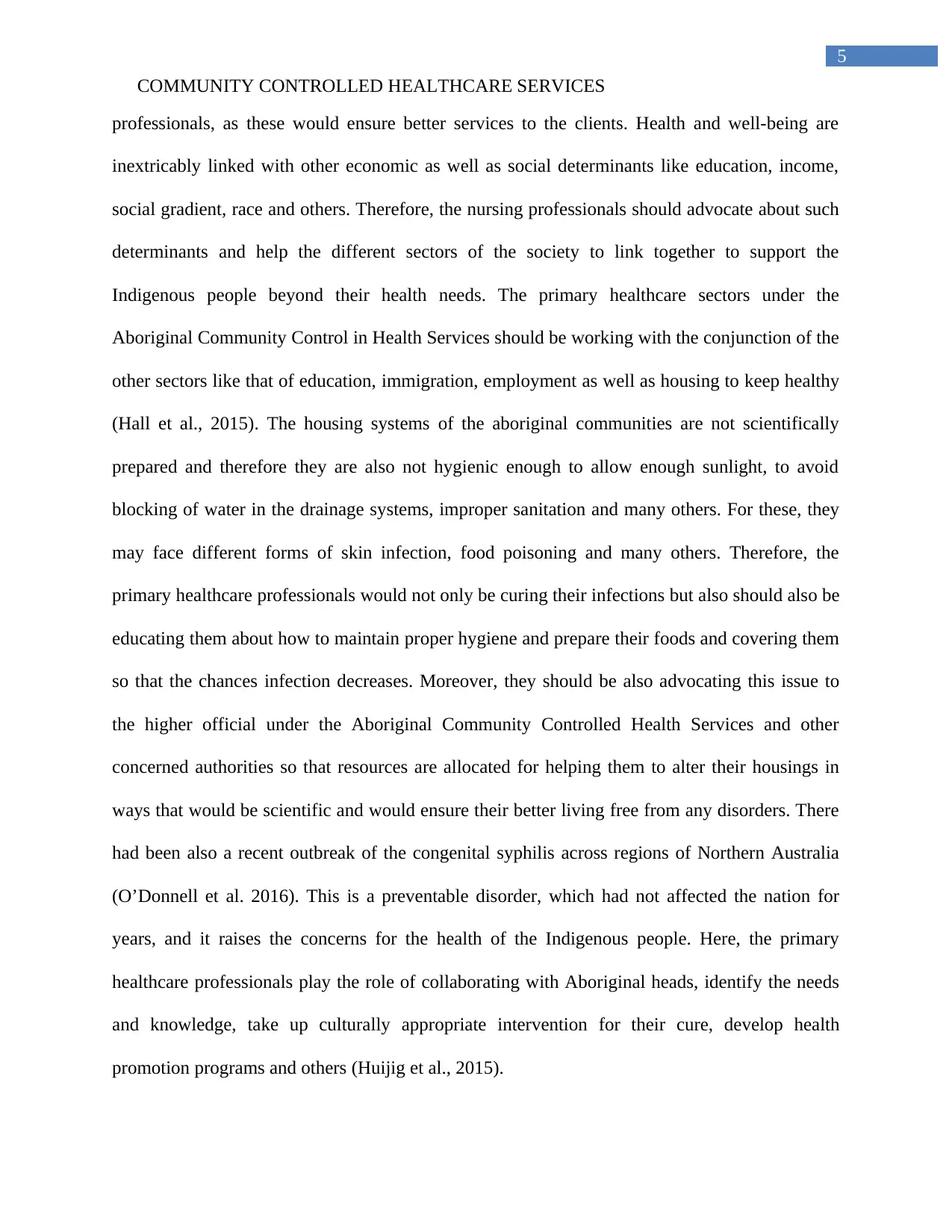
5
COMMUNITY CONTROLLED HEALTHCARE SERVICES
professionals, as these would ensure better services to the clients. Health and well-being are
inextricably linked with other economic as well as social determinants like education, income,
social gradient, race and others. Therefore, the nursing professionals should advocate about such
determinants and help the different sectors of the society to link together to support the
Indigenous people beyond their health needs. The primary healthcare sectors under the
Aboriginal Community Control in Health Services should be working with the conjunction of the
other sectors like that of education, immigration, employment as well as housing to keep healthy
(Hall et al., 2015). The housing systems of the aboriginal communities are not scientifically
prepared and therefore they are also not hygienic enough to allow enough sunlight, to avoid
blocking of water in the drainage systems, improper sanitation and many others. For these, they
may face different forms of skin infection, food poisoning and many others. Therefore, the
primary healthcare professionals would not only be curing their infections but also should also be
educating them about how to maintain proper hygiene and prepare their foods and covering them
so that the chances infection decreases. Moreover, they should be also advocating this issue to
the higher official under the Aboriginal Community Controlled Health Services and other
concerned authorities so that resources are allocated for helping them to alter their housings in
ways that would be scientific and would ensure their better living free from any disorders. There
had been also a recent outbreak of the congenital syphilis across regions of Northern Australia
(O’Donnell et al. 2016). This is a preventable disorder, which had not affected the nation for
years, and it raises the concerns for the health of the Indigenous people. Here, the primary
healthcare professionals play the role of collaborating with Aboriginal heads, identify the needs
and knowledge, take up culturally appropriate intervention for their cure, develop health
promotion programs and others (Huijig et al., 2015).
COMMUNITY CONTROLLED HEALTHCARE SERVICES
professionals, as these would ensure better services to the clients. Health and well-being are
inextricably linked with other economic as well as social determinants like education, income,
social gradient, race and others. Therefore, the nursing professionals should advocate about such
determinants and help the different sectors of the society to link together to support the
Indigenous people beyond their health needs. The primary healthcare sectors under the
Aboriginal Community Control in Health Services should be working with the conjunction of the
other sectors like that of education, immigration, employment as well as housing to keep healthy
(Hall et al., 2015). The housing systems of the aboriginal communities are not scientifically
prepared and therefore they are also not hygienic enough to allow enough sunlight, to avoid
blocking of water in the drainage systems, improper sanitation and many others. For these, they
may face different forms of skin infection, food poisoning and many others. Therefore, the
primary healthcare professionals would not only be curing their infections but also should also be
educating them about how to maintain proper hygiene and prepare their foods and covering them
so that the chances infection decreases. Moreover, they should be also advocating this issue to
the higher official under the Aboriginal Community Controlled Health Services and other
concerned authorities so that resources are allocated for helping them to alter their housings in
ways that would be scientific and would ensure their better living free from any disorders. There
had been also a recent outbreak of the congenital syphilis across regions of Northern Australia
(O’Donnell et al. 2016). This is a preventable disorder, which had not affected the nation for
years, and it raises the concerns for the health of the Indigenous people. Here, the primary
healthcare professionals play the role of collaborating with Aboriginal heads, identify the needs
and knowledge, take up culturally appropriate intervention for their cure, develop health
promotion programs and others (Huijig et al., 2015).
⊘ This is a preview!⊘
Do you want full access?
Subscribe today to unlock all pages.

Trusted by 1+ million students worldwide
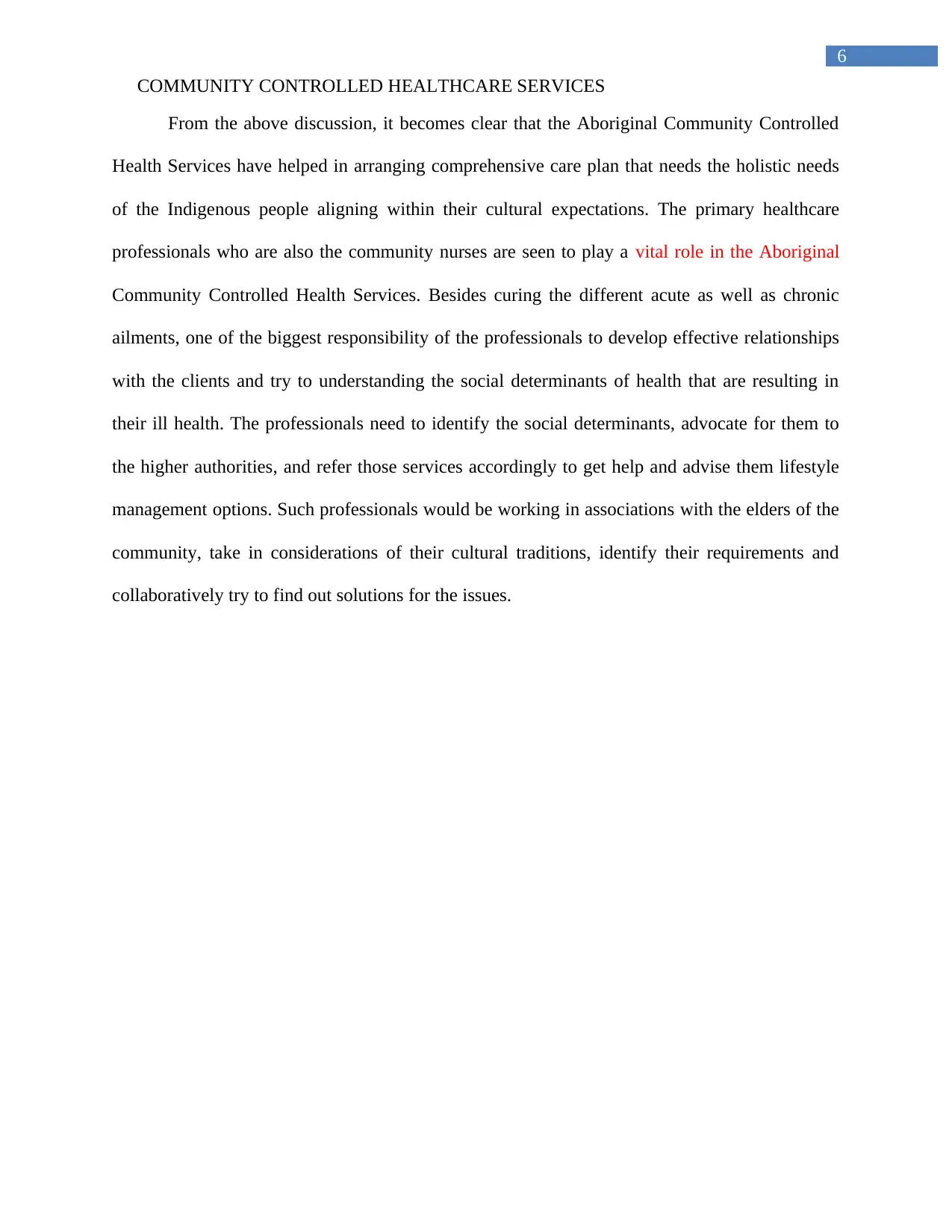
6
COMMUNITY CONTROLLED HEALTHCARE SERVICES
From the above discussion, it becomes clear that the Aboriginal Community Controlled
Health Services have helped in arranging comprehensive care plan that needs the holistic needs
of the Indigenous people aligning within their cultural expectations. The primary healthcare
professionals who are also the community nurses are seen to play a vital role in the Aboriginal
Community Controlled Health Services. Besides curing the different acute as well as chronic
ailments, one of the biggest responsibility of the professionals to develop effective relationships
with the clients and try to understanding the social determinants of health that are resulting in
their ill health. The professionals need to identify the social determinants, advocate for them to
the higher authorities, and refer those services accordingly to get help and advise them lifestyle
management options. Such professionals would be working in associations with the elders of the
community, take in considerations of their cultural traditions, identify their requirements and
collaboratively try to find out solutions for the issues.
COMMUNITY CONTROLLED HEALTHCARE SERVICES
From the above discussion, it becomes clear that the Aboriginal Community Controlled
Health Services have helped in arranging comprehensive care plan that needs the holistic needs
of the Indigenous people aligning within their cultural expectations. The primary healthcare
professionals who are also the community nurses are seen to play a vital role in the Aboriginal
Community Controlled Health Services. Besides curing the different acute as well as chronic
ailments, one of the biggest responsibility of the professionals to develop effective relationships
with the clients and try to understanding the social determinants of health that are resulting in
their ill health. The professionals need to identify the social determinants, advocate for them to
the higher authorities, and refer those services accordingly to get help and advise them lifestyle
management options. Such professionals would be working in associations with the elders of the
community, take in considerations of their cultural traditions, identify their requirements and
collaboratively try to find out solutions for the issues.
Paraphrase This Document
Need a fresh take? Get an instant paraphrase of this document with our AI Paraphraser
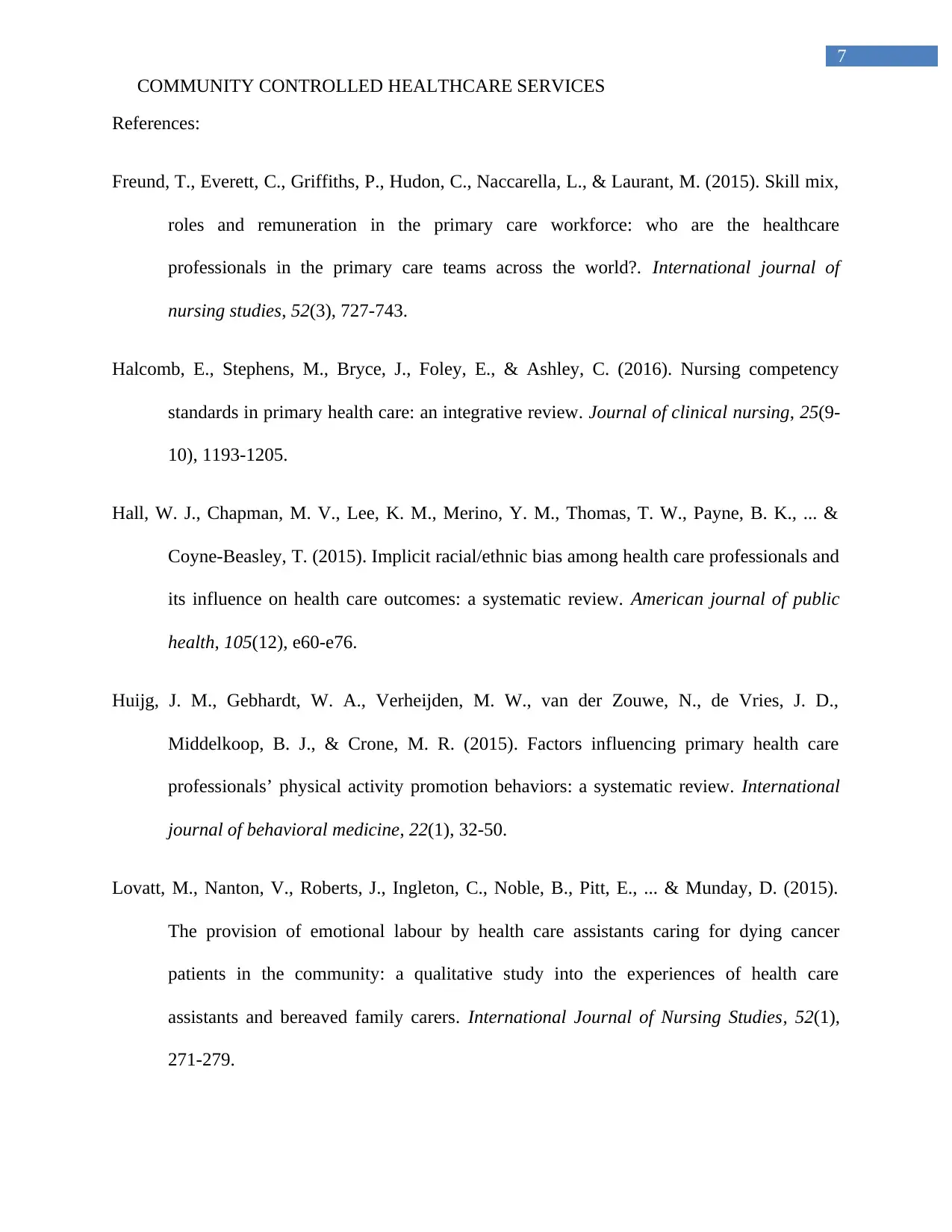
7
COMMUNITY CONTROLLED HEALTHCARE SERVICES
References:
Freund, T., Everett, C., Griffiths, P., Hudon, C., Naccarella, L., & Laurant, M. (2015). Skill mix,
roles and remuneration in the primary care workforce: who are the healthcare
professionals in the primary care teams across the world?. International journal of
nursing studies, 52(3), 727-743.
Halcomb, E., Stephens, M., Bryce, J., Foley, E., & Ashley, C. (2016). Nursing competency
standards in primary health care: an integrative review. Journal of clinical nursing, 25(9-
10), 1193-1205.
Hall, W. J., Chapman, M. V., Lee, K. M., Merino, Y. M., Thomas, T. W., Payne, B. K., ... &
Coyne-Beasley, T. (2015). Implicit racial/ethnic bias among health care professionals and
its influence on health care outcomes: a systematic review. American journal of public
health, 105(12), e60-e76.
Huijg, J. M., Gebhardt, W. A., Verheijden, M. W., van der Zouwe, N., de Vries, J. D.,
Middelkoop, B. J., & Crone, M. R. (2015). Factors influencing primary health care
professionals’ physical activity promotion behaviors: a systematic review. International
journal of behavioral medicine, 22(1), 32-50.
Lovatt, M., Nanton, V., Roberts, J., Ingleton, C., Noble, B., Pitt, E., ... & Munday, D. (2015).
The provision of emotional labour by health care assistants caring for dying cancer
patients in the community: a qualitative study into the experiences of health care
assistants and bereaved family carers. International Journal of Nursing Studies, 52(1),
271-279.
COMMUNITY CONTROLLED HEALTHCARE SERVICES
References:
Freund, T., Everett, C., Griffiths, P., Hudon, C., Naccarella, L., & Laurant, M. (2015). Skill mix,
roles and remuneration in the primary care workforce: who are the healthcare
professionals in the primary care teams across the world?. International journal of
nursing studies, 52(3), 727-743.
Halcomb, E., Stephens, M., Bryce, J., Foley, E., & Ashley, C. (2016). Nursing competency
standards in primary health care: an integrative review. Journal of clinical nursing, 25(9-
10), 1193-1205.
Hall, W. J., Chapman, M. V., Lee, K. M., Merino, Y. M., Thomas, T. W., Payne, B. K., ... &
Coyne-Beasley, T. (2015). Implicit racial/ethnic bias among health care professionals and
its influence on health care outcomes: a systematic review. American journal of public
health, 105(12), e60-e76.
Huijg, J. M., Gebhardt, W. A., Verheijden, M. W., van der Zouwe, N., de Vries, J. D.,
Middelkoop, B. J., & Crone, M. R. (2015). Factors influencing primary health care
professionals’ physical activity promotion behaviors: a systematic review. International
journal of behavioral medicine, 22(1), 32-50.
Lovatt, M., Nanton, V., Roberts, J., Ingleton, C., Noble, B., Pitt, E., ... & Munday, D. (2015).
The provision of emotional labour by health care assistants caring for dying cancer
patients in the community: a qualitative study into the experiences of health care
assistants and bereaved family carers. International Journal of Nursing Studies, 52(1),
271-279.
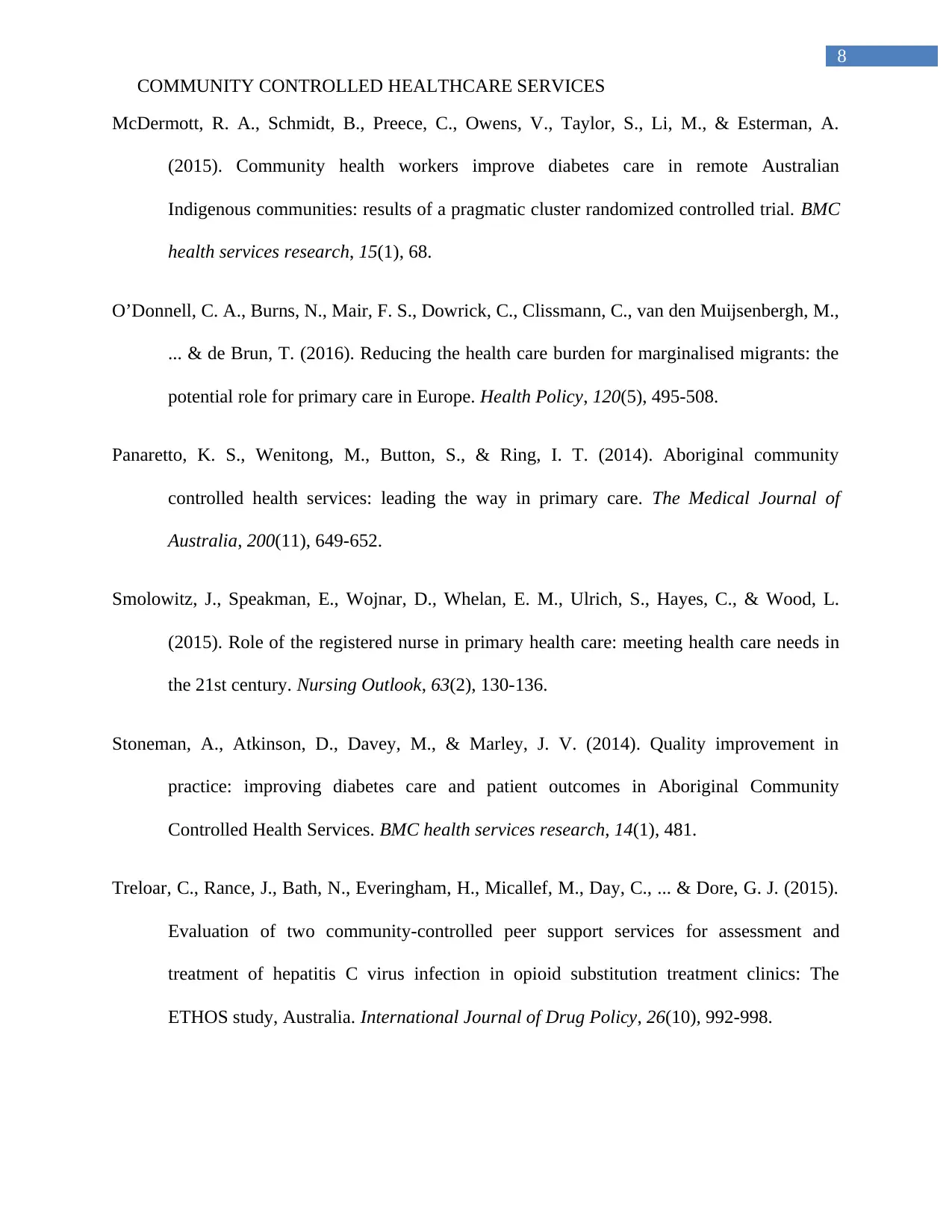
8
COMMUNITY CONTROLLED HEALTHCARE SERVICES
McDermott, R. A., Schmidt, B., Preece, C., Owens, V., Taylor, S., Li, M., & Esterman, A.
(2015). Community health workers improve diabetes care in remote Australian
Indigenous communities: results of a pragmatic cluster randomized controlled trial. BMC
health services research, 15(1), 68.
O’Donnell, C. A., Burns, N., Mair, F. S., Dowrick, C., Clissmann, C., van den Muijsenbergh, M.,
... & de Brun, T. (2016). Reducing the health care burden for marginalised migrants: the
potential role for primary care in Europe. Health Policy, 120(5), 495-508.
Panaretto, K. S., Wenitong, M., Button, S., & Ring, I. T. (2014). Aboriginal community
controlled health services: leading the way in primary care. The Medical Journal of
Australia, 200(11), 649-652.
Smolowitz, J., Speakman, E., Wojnar, D., Whelan, E. M., Ulrich, S., Hayes, C., & Wood, L.
(2015). Role of the registered nurse in primary health care: meeting health care needs in
the 21st century. Nursing Outlook, 63(2), 130-136.
Stoneman, A., Atkinson, D., Davey, M., & Marley, J. V. (2014). Quality improvement in
practice: improving diabetes care and patient outcomes in Aboriginal Community
Controlled Health Services. BMC health services research, 14(1), 481.
Treloar, C., Rance, J., Bath, N., Everingham, H., Micallef, M., Day, C., ... & Dore, G. J. (2015).
Evaluation of two community-controlled peer support services for assessment and
treatment of hepatitis C virus infection in opioid substitution treatment clinics: The
ETHOS study, Australia. International Journal of Drug Policy, 26(10), 992-998.
COMMUNITY CONTROLLED HEALTHCARE SERVICES
McDermott, R. A., Schmidt, B., Preece, C., Owens, V., Taylor, S., Li, M., & Esterman, A.
(2015). Community health workers improve diabetes care in remote Australian
Indigenous communities: results of a pragmatic cluster randomized controlled trial. BMC
health services research, 15(1), 68.
O’Donnell, C. A., Burns, N., Mair, F. S., Dowrick, C., Clissmann, C., van den Muijsenbergh, M.,
... & de Brun, T. (2016). Reducing the health care burden for marginalised migrants: the
potential role for primary care in Europe. Health Policy, 120(5), 495-508.
Panaretto, K. S., Wenitong, M., Button, S., & Ring, I. T. (2014). Aboriginal community
controlled health services: leading the way in primary care. The Medical Journal of
Australia, 200(11), 649-652.
Smolowitz, J., Speakman, E., Wojnar, D., Whelan, E. M., Ulrich, S., Hayes, C., & Wood, L.
(2015). Role of the registered nurse in primary health care: meeting health care needs in
the 21st century. Nursing Outlook, 63(2), 130-136.
Stoneman, A., Atkinson, D., Davey, M., & Marley, J. V. (2014). Quality improvement in
practice: improving diabetes care and patient outcomes in Aboriginal Community
Controlled Health Services. BMC health services research, 14(1), 481.
Treloar, C., Rance, J., Bath, N., Everingham, H., Micallef, M., Day, C., ... & Dore, G. J. (2015).
Evaluation of two community-controlled peer support services for assessment and
treatment of hepatitis C virus infection in opioid substitution treatment clinics: The
ETHOS study, Australia. International Journal of Drug Policy, 26(10), 992-998.
⊘ This is a preview!⊘
Do you want full access?
Subscribe today to unlock all pages.

Trusted by 1+ million students worldwide
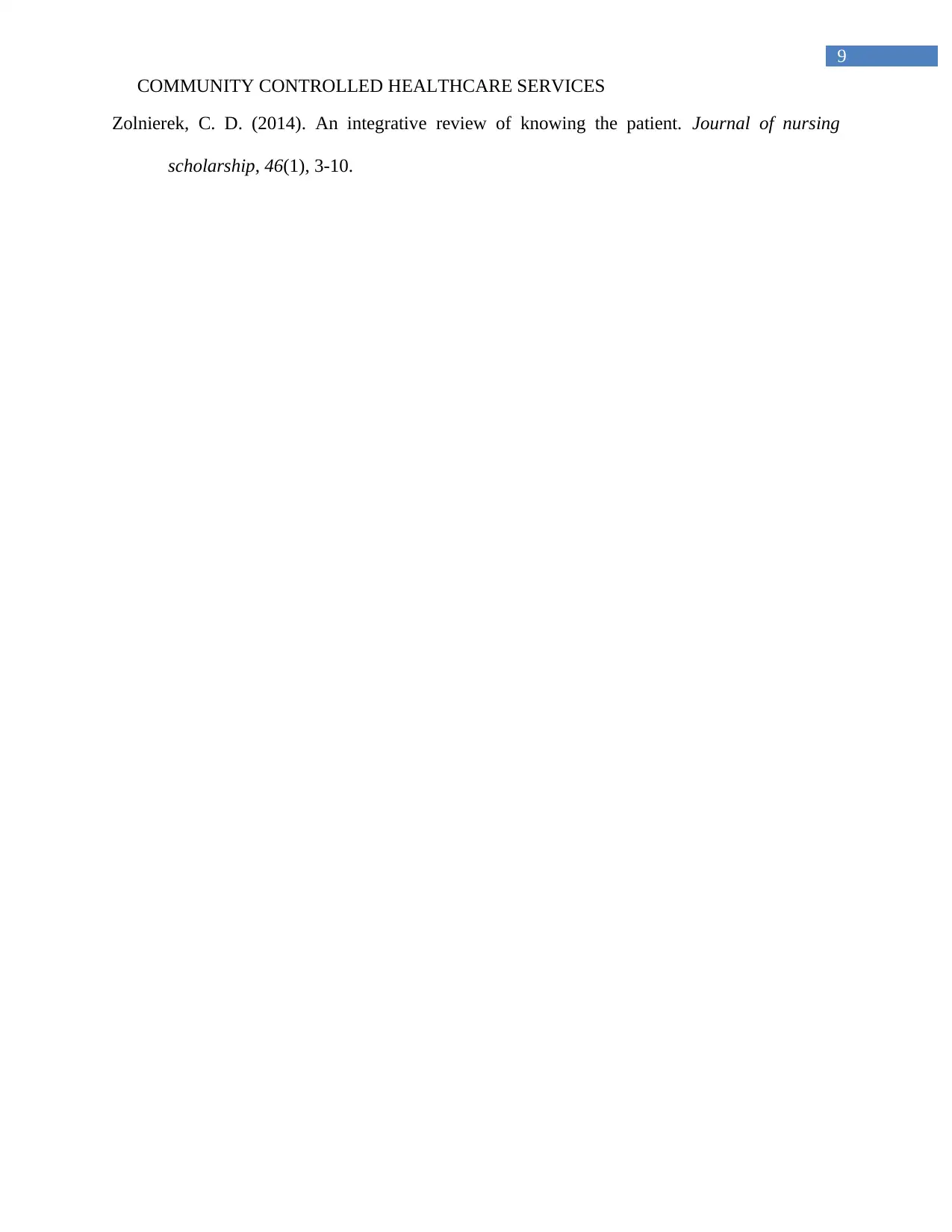
9
COMMUNITY CONTROLLED HEALTHCARE SERVICES
Zolnierek, C. D. (2014). An integrative review of knowing the patient. Journal of nursing
scholarship, 46(1), 3-10.
COMMUNITY CONTROLLED HEALTHCARE SERVICES
Zolnierek, C. D. (2014). An integrative review of knowing the patient. Journal of nursing
scholarship, 46(1), 3-10.
1 out of 10
Related Documents
Your All-in-One AI-Powered Toolkit for Academic Success.
+13062052269
info@desklib.com
Available 24*7 on WhatsApp / Email
![[object Object]](/_next/static/media/star-bottom.7253800d.svg)
Unlock your academic potential
Copyright © 2020–2025 A2Z Services. All Rights Reserved. Developed and managed by ZUCOL.





